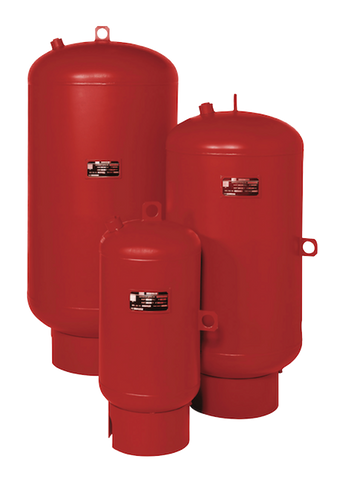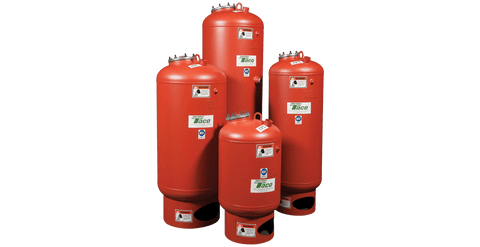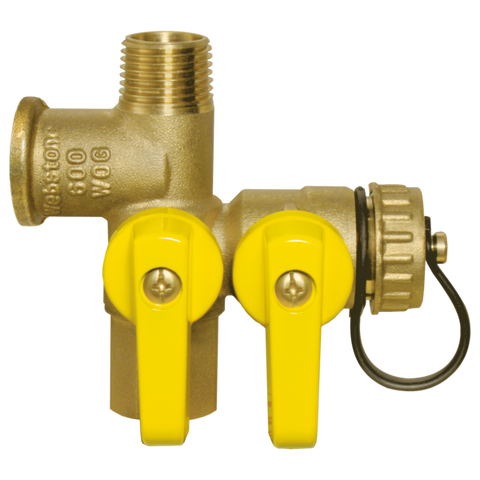Thermal expansion relief valves and tanks are the most common ways to compensate for water expansion in closed-loop systems. They may have the same job, but they look and perform differently.
An expansion tank looks like a small metal container resembling a propane tank and is installed directly above a water heater on the cold water inlet. An expansion tank’s lower half is filled with air (typically at 12 psi pressure), while a rubber bladder installed partway through the tank allows water coming in through the top to push down on the air below. When water heats inside the water heater, the extra moisture and steam leak into the expansion tank, safely occupying the top chamber of an expansion tank until pressure is relieved.

Thermal expansion relief valves are typically a combination ball valve with a low-pressure, spring-loaded safety valve installed in the same place as an expansion tank. However, rather than store any excess steam or moisture, thermal expansion relief valves open and close to relieve water pressure.

Both expansion tanks and thermal expansion relief valves have their advantages and disadvantages. Unlike bulky and expensive expansion tanks, thermal expansion relief valves can save money and space. However, installing an expansion tank can cost more than twice as much as installing a thermal expansion relief valve. In addition, it is difficult to identify a malfunctioning expansion tank. Common issues with expansion tanks include:
- Plumbing Leaks – Expansion tanks often leak due to rusted connectors or piping at the tank inlet. As a result, the tank may fail and need to be replaced within a few years, especially in areas with hard water.
- Surface Condensation – Due to hot water flowing into the expansion tank, significant condensation can form on its surface. In addition, the tank’s proximity to the water heater can add to the problem since the air surrounding the heater also tends to be excessively hot and humid, encouraging condensation. Over time, this leads to corrosion and rust, resulting in leaks.
- Improper Installation – Experts recommend that an expansion tank be installed vertically, with the water heater inlet at the top of the tank. In addition, to safeguard the installation against excessive vibration, securing the tank to a wall with straps is recommended. However, an expansion tank may be installed horizontally or upside down due to space constraints. A hydronic air-lock—a pocket of air trapped below the water—can occur when a tank has been installed upside down, which may cause the expansion tank to fail.
- Rubber Bladder Pinhole Leaks – These are difficult to detect but often cause the expansion tank to fail since the bladder cannot keep the water and air separate.
- Low Air Pressure – Over time, air pressure within the lower chamber of the expansion tank can fall below the required level.
Thermal expansion relief valves are designed for industrial use, often in outdoor and remote locations where regular scrutiny is impossible. Therefore, these safety valves are usually rugged and capable of functioning under adverse conditions. However, a significant drawback of thermal expansion relief valves is the release of excess pressure by allowing expanding hot water to run off into a drain through the outlet pipe, thereby encouraging water waste.
How to Install a Thermal Expansion Relief Valve
Thermal expansion relief valves eliminate the need for an expansion tank, giving you more space and less concern. In addition, this expansion tank replacement reduces fail points within a system.
Expansion Tanks & Valves Available on LibertySupply.com
Bell & Gossett Expansion Tanks
Expansion tanks from Bell & Gossett are designed to absorb the force of thermal expansion in hydronic heating systems and maintain the proper pressurization. Expansion tanks are available in either bladder or diaphragm styles.

Learn more about Bell & Gossett Expansion Tanks
Shop Bell & Gossett Expansion Tanks
Taco Expansion Tanks
Taco offers bladder and diaphragm expansion tanks designed for hydronic systems, hydro-pneumatic, and draw-down applications. Expansion tanks from Taco are tough, durable, long-lasting, and come in various sizes and capacities to fit any application.

Taco Expansion Tanks Playlist
Webstone Pro-Pal Expansion Tank ProService Valves
Pro-Pal expansion tank ProService valves are full port forged brass ball valves with a high-flow hose drain.

- Allows for isolation and draining of an expansion tank in a closed-loop hydronic heating system
- 3-way ball controls flow between the expansion tank and system
- Easily install, isolate, drain, and replace any expansion tank
- Quickly connect the entire system to the cold water feed
- MIP model for direct connection to air Separator or tee
- Replaces 5 components
- Eliminates 4 leak paths
- Available in FIP x MIP x FIP x Hose, FIP x FIP x FIP x Hose
- Certified to NSF/ANSI 61

Shop Webstone Pro-Pal Expansion Tank ProService Valves
Other Expansion Tanks & Thermal Expansion Relief Valves
Although not available online, Liberty Supply offers expansion tanks from manufacturers such as Armstrong Fluid Technology, Grundfos, and more. Thermal expansion relief valves are available from Watts, Zurn, SharkBite, and more. Call us at 844-448-0880 or email us at support@libertysupply.com to talk to a sales representative to find out more or get a quote.

